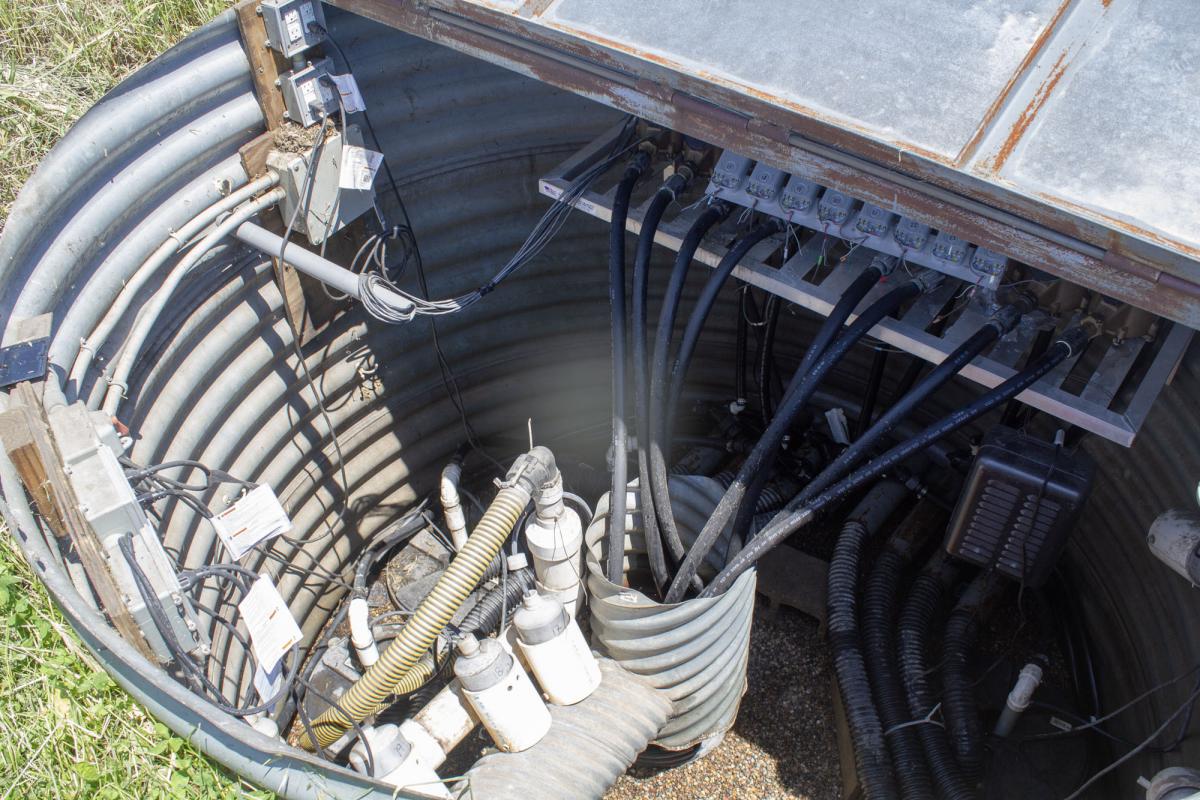
USDA microbiologist Tom Moorman kneels beside the collection system that segregates water from unique drain lines placed under 24 different plots. (Amy Mayer/Harvest Public Media)
At the edge of a corn field on a clear but windy June day, microbiologist Tom Moorman lifts a metal lid and reveals a collection of bottles, tubes, meters and cables in a shallow pit. The system is designed to capture runoff from 24 plots.
Moorman and his research group then analyze the nutrients in the water from each container to measure runoff levels. They're comparing different cover crops.
"We have two basic ones that we're looking at here," he says, standing among the rows, "rye cover crops, which we've looked at for quite some time. But this particular treatment, instead of rye, we're trying to grow winter camelina."

Camelina is an oilseed that can be planted in the fall and harvested in the summer even as soybeans are growing in the rows around it.
Moorman, who works for the Agricultural Research Service of the U.S. Department of Agriculture in Ames, Iowa, has been looking at whether the camelina cover crop reduces nutrient runoff. He measures nitrate, phosphorus and potassium in the collected water.
Beyond keeping the soil and nutrients on the field -- the goal of a cover crop -- Moorman wants to see whether camelina might also provide farmers with a third cash crop, in addition to corn and soybeans. Camelina can be used in industrial products and processed into a vegetable oil high in omega-3 fatty acids.
Such an addition, he says, has long been a goal.
"Agricultural scientists in the Midwest have spent a lot of time thinking about another big third crop," he says. "And we haven't come up with it exactly yet."
But these experiments aren't just for local farmers. These plots are part of the Upper Mississippi River Basin site of the Long Term Agroecosystem Research (LTAR) network.
Climate change and the environmental damage caused by large-scale agriculture have researchers across the country searching for ways to increase productivity without causing more damage.
Formally established in 2012, the LTAR has been working to combine local data into a national understanding of what might need to change.
It currently has 18 sites and was inspired by the 40-year-old Long Term Ecological Research (LTER) network, which has demonstrated both the value of continued data collection and the power of collaboration in field science. The ecological network has received continuous funding from the National Science Foundation and has produced volumes of peer-reviewed scientific papers. The agroecosystem network is still establishing data management and collaboration strategies.
Decades of data
In Michigan, the Kellogg Biological Station is one of the few LTAR sites that is also part of the ecological research network. Scientists there have been studying the impact of no-till farming for decades.
Nick Haddad, one of the researchers there and a professor at Michigan State University, says their results are conclusive: not breaking up and turning over the land before planting is beneficial, for yield and for the environment, when you do it year after year.
"If we had stopped at any point in that 30 years, we wouldn't know the extent that a less intense cropping system has on yield," he says.
Plus, Haddad says no-till leads to higher soil moisture and keeps more carbon in the ground. He says the results likely would hold true on 20-40 percent of Upper Midwest corn fields.
But the agricultural landscape looks different in Nebraska, where there's more livestock and less water. The Platte River/High Plains Aquifer site of the agroecosystem network has records on ground water, pesticide residue, productivity and more.
"We have several long-term data sets, several of them go back to the '70s, few go back to the '40s," says Tala Awada, a dean and professor at the University of Nebraska Lincoln and co-leader of the site. "The groundwater fluctuation goes back (to) the early 1900s."
The data helped land managers advise local farmers for decades.
Planning for changes
Now the LTAR network is exploring water quantity and quality, greenhouse gas emissions and other environmental impacts across many agricultural landscapes. The coordinated effort aims to illustrate how the different regions are related.
"We are all facing changes in the environment, changes in climate, that one of us cannot capture," Awada says. But collectively, they can better understand the continent-wide scope of agricultural impact on the environment and what adaptations are most promising.
Teferi Tsegaye, national coordinator of the network at the Agricultural Research Service office in Maryland, says with a growing global population and no additional arable land, sustainably increasing production is a must.
"We have one Earth, basically," he says. "So you have to increase the productivity with (the) same land that we are currently producing."
Researchers hope their work will demonstrate viable ways for farmers to do that.
Follow Amy on Twitter:@AgAmyinAmes












